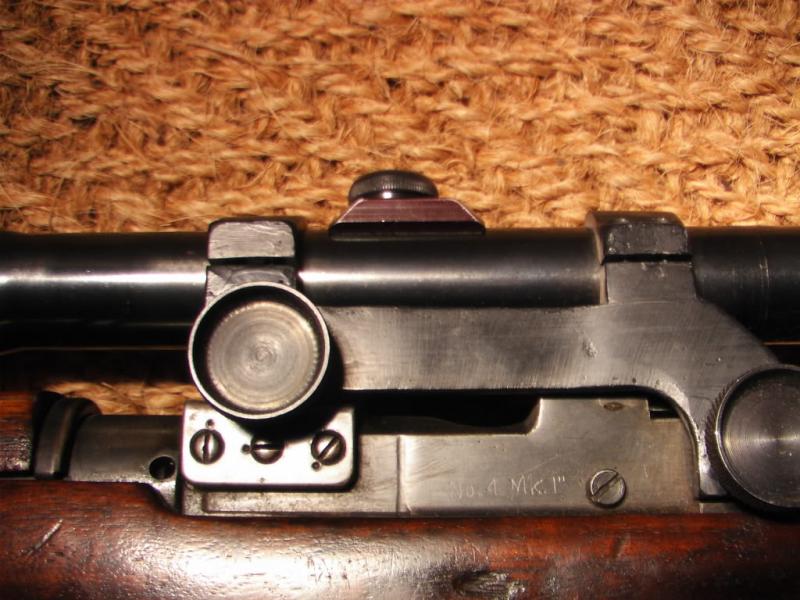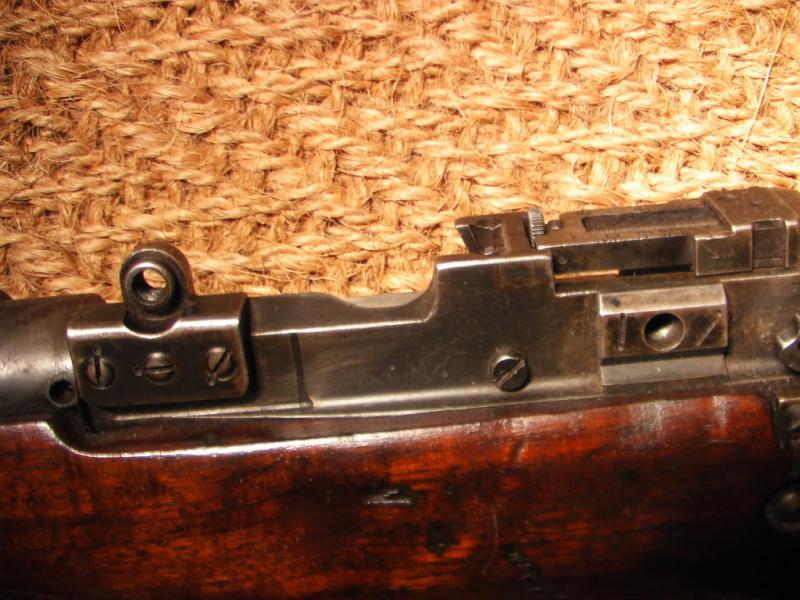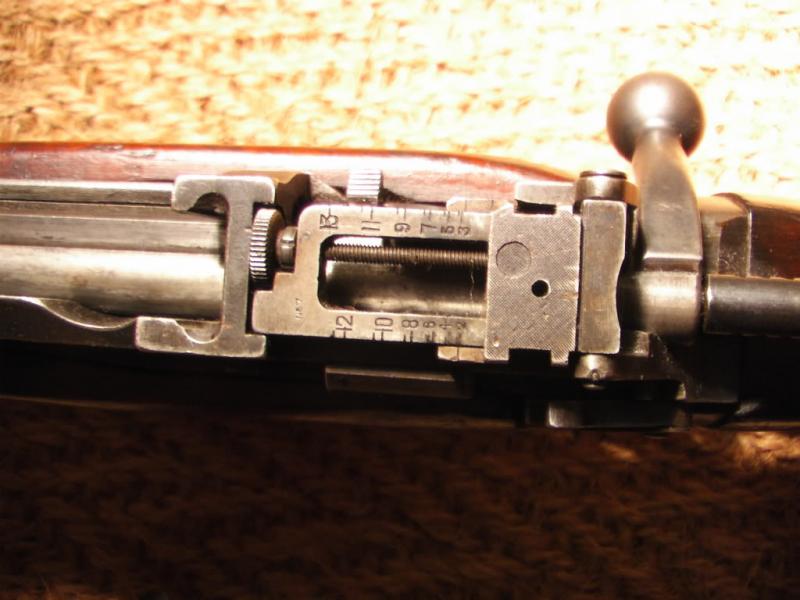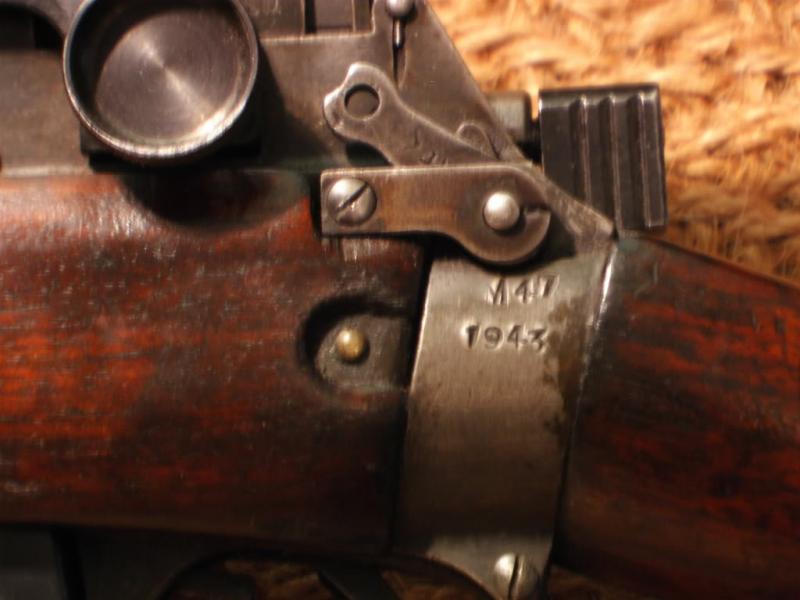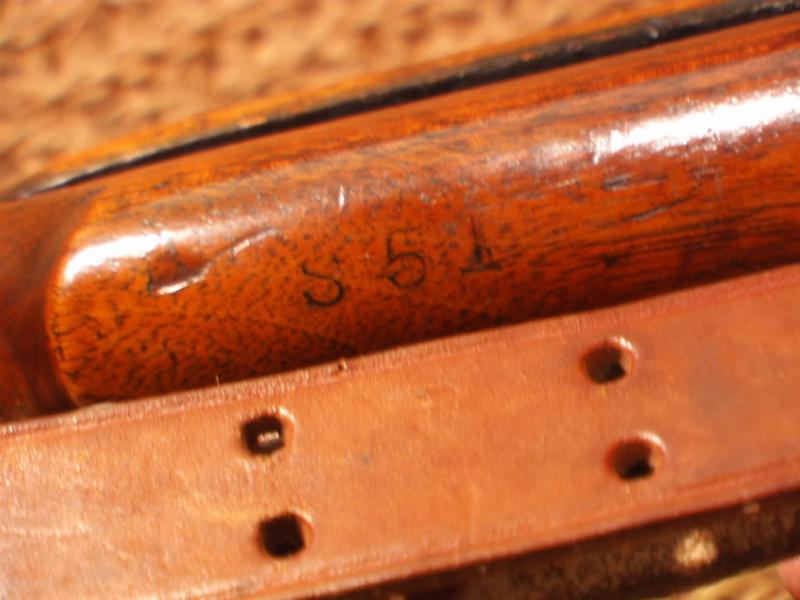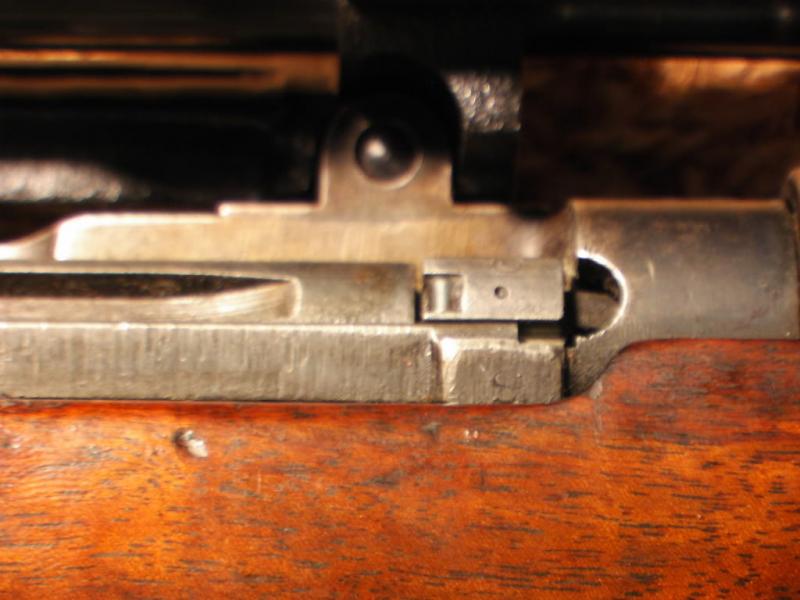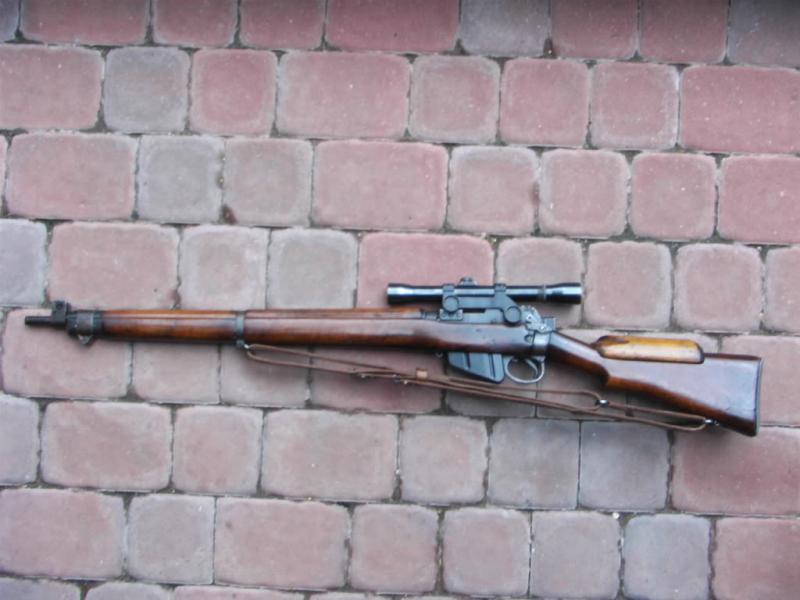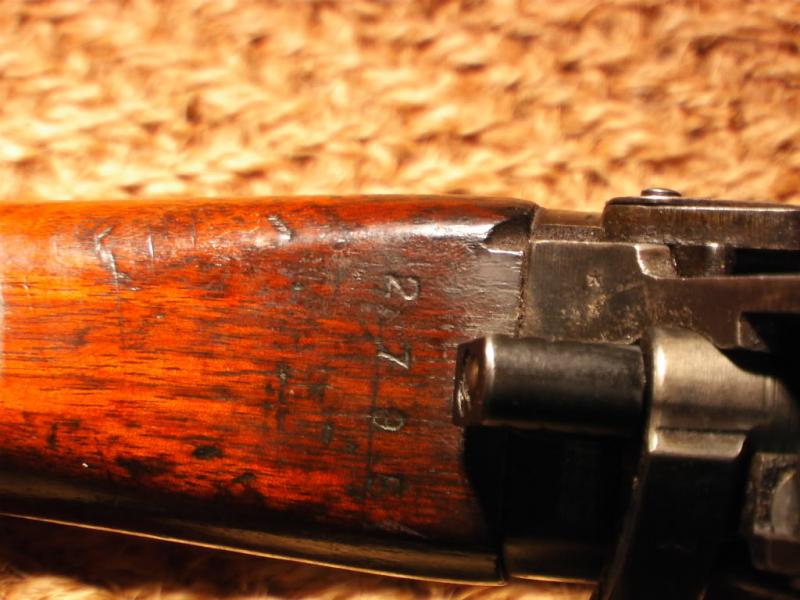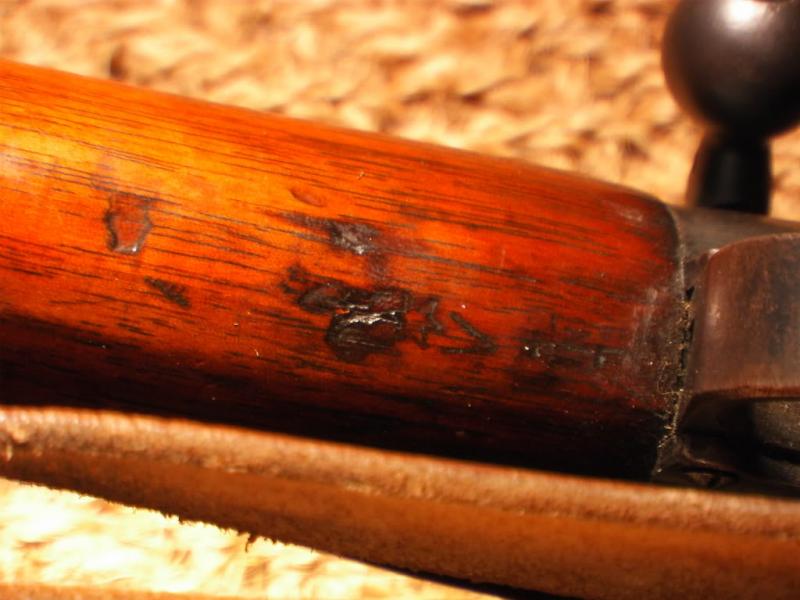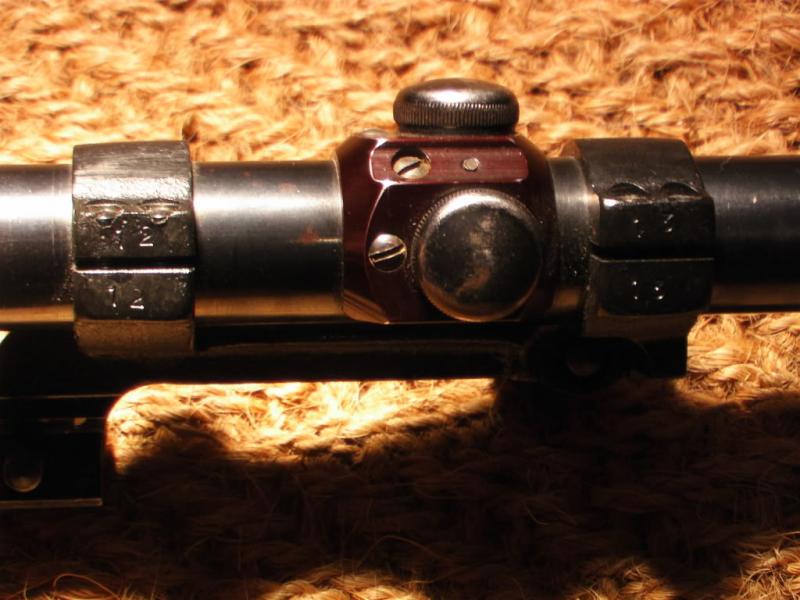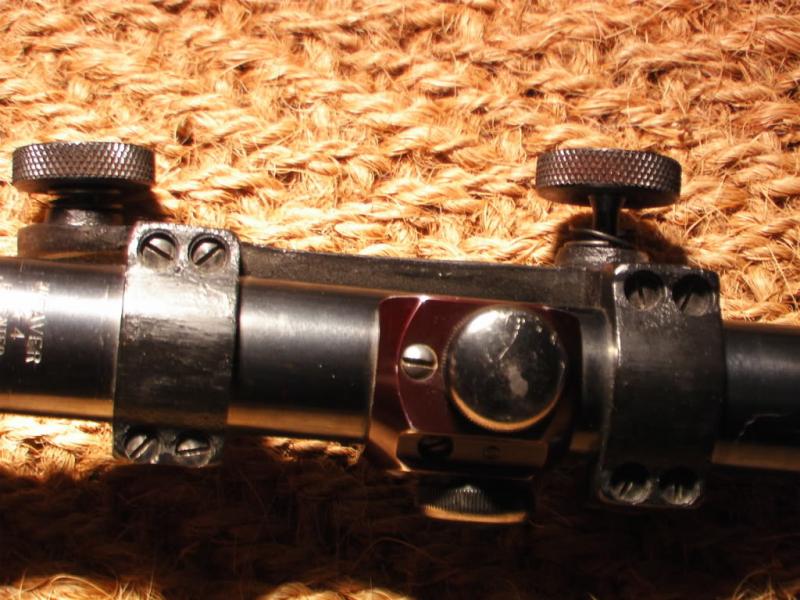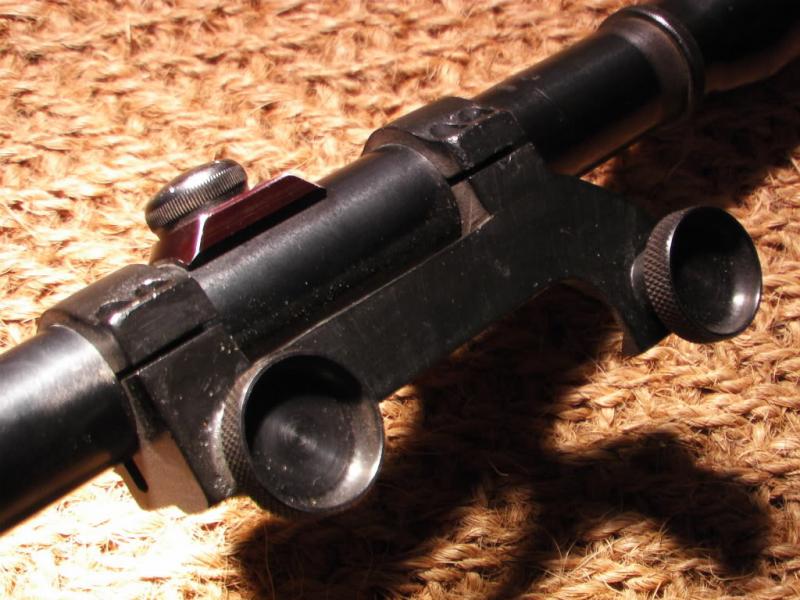-
FREE MEMBER
NO Posting or PM's Allowed

A genuine No.4 Mk1 "T" that is not marked T or TR?
Hello all! I'm new to the forum and Lee-Enfields. I have recently aquired my first No.4 Mk1. The rifle is marked on the butt socket M47 1943 AQ2902. The bolt serial number is also AQ2902. As the title of the post indicates this rifle is not marked TR nor does it have a T marked anywhere on it. I understand that this makes it highly suspect as a genuine sniper rifle. The strange part is the buttstock (with cheek piece) is clearly stamped S 51. I firmly believe that it has been attached to this rifle since day one. Also, the small 1/8" S is stamped on the right side, behind the receiver ring, just above the wood. The rifle has properly staked, matching finish, scope mounting pads, and scope mount with a vintage Weaver K4 scope mounted.
Though the rifle looks like it's been well used, it still shot better than 1.25 MOA with the S&B ball ammo I used.This rifle was a real pleasure to shoot so I'm pleased with it no matter what. In fact, it is more accurate than either of my two WWII era Remington 1903's. What are the chances that this rifle actually is a sniper rifle?
Information
 |
Warning: This is a relatively older thread
This discussion is older than 360 days. Some information contained in it may no longer be current. |
|
-
04-25-2009 09:55 AM
# ADS
Friends and Sponsors

-
Legacy Member


Photo would be a great help in answering your question.
Cheers
..MJ..
-
-
-
FREE MEMBER
NO Posting or PM's Allowed

Is My Lee Enfield Sniper Rifle a Fake--by Terry Warner
In the Interest of helping here is a good article based on one than one good book-several in fact.
So here you go---
This article is from;
Terry Warners article--
IS MY LEE ENFIELD SNIPER RIFLE A FAKE!
at
Spotting a fake sniper rifle
Besides looking for both ‘T’ and ‘TR’, one very simple test is to examine the screw heads on the pads. Staking the end of the slot with a pin punch is an uncomplicated way to lock a screw head, and was listed in the armourer’s orders in March 1946. More than one stake per screw head, indicates the pad has been removed or replaced, either for repair or overhaul. A single stake mark suggests a rifle is newly converted, was not used very much, or left British service prior to 1946. The front pad takes the worst beating of the two.
service prior to 1946. The front pad takes the worst beating of the two.
To summarize Laidler , the first guideline is to examine the left side of the receiver. Read the model number. All British and Savage-made sniper rifles were built on No.4 Mk1 actions (“number four mark one”). Only wartime dated Long Branch No.4 Mk1* (“number four mark one star”) receivers were converted to sniper rifles. If a rifle from two British plants was more accurate than average, it was set aside for No.4(T) conversion. Birmingham Small Arms’ plant in Shirley stamped their ‘M47C’ on the butt socket. Royal Ordnance Factory in Maltby stamped ‘ROFM’ ‘RM’ or ‘M’ on the sidewall or on the butt socket. The serial number ranges are listed in Stratton.
, the first guideline is to examine the left side of the receiver. Read the model number. All British and Savage-made sniper rifles were built on No.4 Mk1 actions (“number four mark one”). Only wartime dated Long Branch No.4 Mk1* (“number four mark one star”) receivers were converted to sniper rifles. If a rifle from two British plants was more accurate than average, it was set aside for No.4(T) conversion. Birmingham Small Arms’ plant in Shirley stamped their ‘M47C’ on the butt socket. Royal Ordnance Factory in Maltby stamped ‘ROFM’ ‘RM’ or ‘M’ on the sidewall or on the butt socket. The serial number ranges are listed in Stratton.
There was a continual reduction of sniper rifles in British service after 1945 until the 1960’s. Those unsuited for upgrade programs or surplus were sold off. Remaining rifles were converted to L42 rifles in 7.62 NATO. Therefore, a British rifle has a storybook of markings establishing its history. Canadian issued rifles usually do not have the characteristic British speckling of stamps and punches. The collector must educate himself on the nuances of each stamp and punch. They are not random, but tell a lengthy and detailed story beyond the intent of this article.
Still following Laidler, the second guideline is to look for a large ‘TR’ stamped on the left of the butt socket and a letter ‘T’ on the flat of the left receiver sidewall after the model number. The fonts are distinctive. The ‘TR’ was applied by inspectors at the plant to indicate the rifle grouped better than others. It was segregated and shipped to Holland and Holland. The new arrivals were inspected again, and those that met a higher standard were converted. Some rejected ‘TR’ rifles may be in circulation without other sniper marks. The ‘T’ signified a No.32 telescope had been fitted, and the combination met all inspections. Without a ‘T’ marking, the rifle could not have been converted at Holland and Holland or Long Branch, except for defined batches of rifles converted before the marking procedures were settled.
The third guideline is to look for a ¼ inch ‘S51’ stamped on the bottom of the handgrip of the butt stock. This is unique to Holland and Holland. The standard length butt was a Normal marked with a letter ‘N’ on the top near the butt plate. There will be a check rest with a scalloped front end screwed to the comb. There are some variations in the finished shape and centering of the cheek rest. Some rifles have it more upright while others tend to have the rest rolled to either side. Unbuggered screw heads on slotted screws are an encouraging sign. Look for a stamped telescope number on the front edge of the butt, just before butt socket. If possible (but I strongly advise against amateurs touching any tool to a collectable rifle), unscrew the butt and look on the wood for the rifle serial number just in front of the scope number.
Look at the stock, look for a screw from one side of the wood to the other just in front of the receiver ring. This is the dreaded Ishapore screw. The Indians modified every No.4 rifle they found with this strengthening screw. Nobody else worried about such things. Although, India did use unknown numbers of No.4(T) rifles, but the references give no indication of Indian markings.
Look on the front right side of the receiver just behind the receiver ring. A genuine Holland and Holland conversion will have a 1/8 inch letter ‘S’ close to the wood line. I cannot comment if Long Branch is marked as such.
If there is an angular sling swivel on the takedown screw in front of the magazine, this is a sign, A) the rifle was either produced after September 1944, B) it left British military sometime near then, or C) someone has ‘improved’ the rifle. A considerable number of civilian Parker Hale target shooting swivels change hands on the internet, regardless of appropriateness for the year of No.4(T) production.
Look at the sights. Are both surfaces on the front sight blade, which face the shooter, undercut? Apparently some snipers found the normal slope reflected back on their eyes. I wouldn’t worry if it is not there. It may be a peculiarity of British unit-level conversions. The back sight should be the machined early Mk.I style, without the 90 degree battle sight. It should be completely black with no exposed metal surfaces. One sign the rifle has been used by someone knowledgeable will be if the underside is rounded out. Smart armourers made this modification (without permission) so their sniper comrades could remove the rifle bolt without removing the scope and flipping up the back sight.
The next to last item(s) are the accessories according to the equipment checklists. Every well-dressed No.4(T) has: a No.15 wooden transport chest; a No.8 scope case and leather strap or No.8 MK.2 rubberized canvas sleeve; a canvas protective case that is too small for a rifle with scope; a Scout Regiment ‘pirate-style’ draw tube telescope; a small tin cleaning kit; and a World War I dated American M1907 leather sling. Each item is a study in itself. Generally speaking, collectors look for matching numbers to their rifle and telescope, and for example, a Broad Arrow on the sling. Any No.8 case or sleeve, and surprisingly the can’s strap, are highly sought after, followed by the No.15 chest. The Canadian C No.7 .22 rifle chest is similar, but not tall enough by 2 inches.
The final item from Laidler’s books is the No.32 telescope and mounting bracket or base. If the rifle offered does not have a No.32 scope, be skeptical. Remember, the Century rifles are sold without brackets or scopes. If there is a scope, compare its number to the stamped number on the butt and the rifle number to the one on the bracket. If they match, Bingo! We have a winner. If not, don’t despair. Most No.4(T)s sold for surplus in Canada have mismatched numbers. The dealers stored the rifles unheated and the scopes heated; most salesmen or shippers didn’t know or care to match them up. It is not unreasonable to suspect a similar tale elsewhere.
have mismatched numbers. The dealers stored the rifles unheated and the scopes heated; most salesmen or shippers didn’t know or care to match them up. It is not unreasonable to suspect a similar tale elsewhere.
In broad terms, a 1941, ‘42 or ‘43 rifle should have a MK1 scope; rifles made in ’43 and ‘44 should have a MK2 scope, and rifles made in ‘45 a MK3 or C No.67 scope (also known as a Mk4). Canadian-made REL scopes restart serial numbers with each mark change. Only a few hundred REL scopes of each mark were ever produced, so overall they are exceedingly scarce. An REL scope on a British rifle or a Long Branch rifle with British scope should be approached skeptically. The best British MK3 scopes were kept for the 7.62 conversion program, as earlier Marks were no longer needed. Some good condition MK3 scopes were sold off.
There are a number of replica scope brackets on the market. US companies like SARCO and The Sportsman’s Guide sell fake sniper rifle mounts. It has an obvious two-faceted rear face. The author succumbed to a testosterone race and bought a not-so-cleared explained replica bracket for 50% more than the retailer was asking. On the other extreme are brackets made in the UK for Roger Payne . His products are high quality and esthetically close to the original, but still distinctive to the knowledgeable collector.
. His products are high quality and esthetically close to the original, but still distinctive to the knowledgeable collector.
The flat side will be flat, not sharply angled. Look for a round radius on the rear “arm” of the bracket and a short vertical rise from the rear finger knob. The originals were cast iron, with limited machining for the scope contact surfaces, the ring halves, and the bearing surfaces at the pads. Postwar, the British rifles stamped the rifle serial number on the rear leg. Long Branch serialized the bracket to the rifle, centered near the top edge.
Canadian knobs have a small depression in their centre. The British knobs are smooth surfaced inside. There are two styles of split washers which are not interchangeable.
Laidler suggests if the pads have tiny Broad Arrow marks, they are replacement parts from authorized sources. However, there are replica No.4(T) parts kits on the market. One internet seller includes drills, taps and screws with a set of pads. Hardware is one thing, talent is another. The key ingredient in the Holland and Holland conversion was two operators and three machines using all the same jigs. They converted rifles on a production line of one rifle after another. Every faker is trying to replicate that unique set of conditions. Without a good knowledge of the factors, it is unlikely to get the pads properly centered and aligned over the bore. A fake rifle and pads are unlikely to be aligned to the natural centre of the telescope’s adjustment.
---------------------------------
Having read all that you just might have something resembling the Century fake snipers that were accurate rifles set aside at the factory for conversion to -T- status but never done. They are not LE sniper rifles. But from the lacking of a few details it seems not likely that your rifle was a century-sale. It could be an older T rifle -read the early part of the above sniper story-- also is the scope pad serial numbered to the receiver?
If it is good. If it is not and the screws are staked you have a parts gun in all likelihood. If the scope mount is not serialled to the gun you have a fake. BUT IT IS ALL IN QUESTION YOU NEED TO POST US SOME GOOD PICTURES OF--
a)receiver left wall--good resolution pic
b)left butt socket wall -good pic
c) wood markings on butt and foreend
d) -S- stamp in the receiver ring-these have been faked in the past.
e) close up of the scope pads and screws
f) close up of the scope mounts,screws and stamps (numbers)
g) closeup of the rear sight
-
Legacy Member


Originally Posted by
terryinvictoria

If it is good. If it is not and the screws are staked you have a parts gun in all likelihood. If the scope mount is not serialled to the gun you have a fake.
Didn't mr Laidler recently post that the mount was only serialled to the gun if it had been changed?
Edit ah yes found it:
Numbering No4T telescope brackets wasn't an Armourers whim thing but an instruction AFTER 'Instructions for Armourers' during the very short time of 'SmallArms Instructions' (SAI's) but prior to the current (?) EMER's. As a result, it got lost in the changeover due to the fact that SAI's were a simple printed paper note that went to Regimental Quartermasters and didn't get passed down the chain of command to the Armourers. So there was both authority AND detaled instructions.
The REASON for numbering the bracket was that Armourers soon found that while the telescope and rifle were cross matched on the tin and the butt, there was no cross matching of the bracket. This was the MOST important cross match of all because while the telescopes were all pretty well interchangeable (within the bounds of reason of course) due to the bracket being line bored/collimated to the bore of the rifle. The bracket definately IS NOT inmterchangeable. Though they might FIT, that isn't the same as interchangeability.
As a result, if a bracket was changed from one rifle to another, then adjusted to become a perfect mechanical fit AND allowed the centralised telescope to correctly align with the bore, only then was it was numbered to the rifle. This was renumbered/stamped before securing the telescope into the cradles. After all, you don't want to stamp the cradle with a number while the telescope is in place ....., not twice you won't!
As a general rule of thumb, but not definitive by any means, if your bracket IS numbered, then it means that it has been changed to another rifle. After all, just ask yourself WHY would it be numbered if it was original and never been separated? The bracket is numbered because it's more important to keep THIS matched with the rifle than the telescope.
Last edited by PrinzEugen; 04-25-2009 at 01:09 PM.
Reason: more info
-
-
FREE MEMBER
NO Posting or PM's Allowed

Is My Lee Enfield Sniper Rifle a Fake--by Terry Warner
In the Interest of helping here is a good article based on one than one good book-several in fact.
So here you go---
This article is from;
Terry Warners article--
IS MY LEE ENFIELD SNIPER RIFLE A FAKE!
at
Spotting a fake sniper rifle
Besides looking for both ‘T’ and ‘TR’, one very simple test is to examine the screw heads on the pads. Staking the end of the slot with a pin punch is an uncomplicated way to lock a screw head, and was listed in the armourer’s orders in March 1946. More than one stake per screw head, indicates the pad has been removed or replaced, either for repair or overhaul. A single stake mark suggests a rifle is newly converted, was not used very much, or left British service prior to 1946. The front pad takes the worst beating of the two.
service prior to 1946. The front pad takes the worst beating of the two.
To summarize Laidler , the first guideline is to examine the left side of the receiver. Read the model number. All British and Savage-made sniper rifles were built on No.4 Mk1 actions (“number four mark one”). Only wartime dated Long Branch No.4 Mk1* (“number four mark one star”) receivers were converted to sniper rifles. If a rifle from two British plants was more accurate than average, it was set aside for No.4(T) conversion. Birmingham Small Arms’ plant in Shirley stamped their ‘M47C’ on the butt socket. Royal Ordnance Factory in Maltby stamped ‘ROFM’ ‘RM’ or ‘M’ on the sidewall or on the butt socket. The serial number ranges are listed in Stratton.
, the first guideline is to examine the left side of the receiver. Read the model number. All British and Savage-made sniper rifles were built on No.4 Mk1 actions (“number four mark one”). Only wartime dated Long Branch No.4 Mk1* (“number four mark one star”) receivers were converted to sniper rifles. If a rifle from two British plants was more accurate than average, it was set aside for No.4(T) conversion. Birmingham Small Arms’ plant in Shirley stamped their ‘M47C’ on the butt socket. Royal Ordnance Factory in Maltby stamped ‘ROFM’ ‘RM’ or ‘M’ on the sidewall or on the butt socket. The serial number ranges are listed in Stratton.
There was a continual reduction of sniper rifles in British service after 1945 until the 1960’s. Those unsuited for upgrade programs or surplus were sold off. Remaining rifles were converted to L42 rifles in 7.62 NATO. Therefore, a British rifle has a storybook of markings establishing its history. Canadian issued rifles usually do not have the characteristic British speckling of stamps and punches. The collector must educate himself on the nuances of each stamp and punch. They are not random, but tell a lengthy and detailed story beyond the intent of this article.
Still following Laidler, the second guideline is to look for a large ‘TR’ stamped on the left of the butt socket and a letter ‘T’ on the flat of the left receiver sidewall after the model number. The fonts are distinctive. The ‘TR’ was applied by inspectors at the plant to indicate the rifle grouped better than others. It was segregated and shipped to Holland and Holland. The new arrivals were inspected again, and those that met a higher standard were converted. Some rejected ‘TR’ rifles may be in circulation without other sniper marks. The ‘T’ signified a No.32 telescope had been fitted, and the combination met all inspections. Without a ‘T’ marking, the rifle could not have been converted at Holland and Holland or Long Branch, except for defined batches of rifles converted before the marking procedures were settled.
The third guideline is to look for a ¼ inch ‘S51’ stamped on the bottom of the handgrip of the butt stock. This is unique to Holland and Holland. The standard length butt was a Normal marked with a letter ‘N’ on the top near the butt plate. There will be a check rest with a scalloped front end screwed to the comb. There are some variations in the finished shape and centering of the cheek rest. Some rifles have it more upright while others tend to have the rest rolled to either side. Unbuggered screw heads on slotted screws are an encouraging sign. Look for a stamped telescope number on the front edge of the butt, just before butt socket. If possible (but I strongly advise against amateurs touching any tool to a collectable rifle), unscrew the butt and look on the wood for the rifle serial number just in front of the scope number.
Look at the stock, look for a screw from one side of the wood to the other just in front of the receiver ring. This is the dreaded Ishapore screw. The Indians modified every No.4 rifle they found with this strengthening screw. Nobody else worried about such things. Although, India did use unknown numbers of No.4(T) rifles, but the references give no indication of Indian markings.
Look on the front right side of the receiver just behind the receiver ring. A genuine Holland and Holland conversion will have a 1/8 inch letter ‘S’ close to the wood line. I cannot comment if Long Branch is marked as such.
If there is an angular sling swivel on the takedown screw in front of the magazine, this is a sign, A) the rifle was either produced after September 1944, B) it left British military sometime near then, or C) someone has ‘improved’ the rifle. A considerable number of civilian Parker Hale target shooting swivels change hands on the internet, regardless of appropriateness for the year of No.4(T) production.
Look at the sights. Are both surfaces on the front sight blade, which face the shooter, undercut? Apparently some snipers found the normal slope reflected back on their eyes. I wouldn’t worry if it is not there. It may be a peculiarity of British unit-level conversions. The back sight should be the machined early Mk.I style, without the 90 degree battle sight. It should be completely black with no exposed metal surfaces. One sign the rifle has been used by someone knowledgeable will be if the underside is rounded out. Smart armourers made this modification (without permission) so their sniper comrades could remove the rifle bolt without removing the scope and flipping up the back sight.
The next to last item(s) are the accessories according to the equipment checklists. Every well-dressed No.4(T) has: a No.15 wooden transport chest; a No.8 scope case and leather strap or No.8 MK.2 rubberized canvas sleeve; a canvas protective case that is too small for a rifle with scope; a Scout Regiment ‘pirate-style’ draw tube telescope; a small tin cleaning kit; and a World War I dated American M1907 leather sling. Each item is a study in itself. Generally speaking, collectors look for matching numbers to their rifle and telescope, and for example, a Broad Arrow on the sling. Any No.8 case or sleeve, and surprisingly the can’s strap, are highly sought after, followed by the No.15 chest. The Canadian C No.7 .22 rifle chest is similar, but not tall enough by 2 inches.
The final item from Laidler’s books is the No.32 telescope and mounting bracket or base. If the rifle offered does not have a No.32 scope, be skeptical. Remember, the Century rifles are sold without brackets or scopes. If there is a scope, compare its number to the stamped number on the butt and the rifle number to the one on the bracket. If they match, Bingo! We have a winner. If not, don’t despair. Most No.4(T)s sold for surplus in Canada have mismatched numbers. The dealers stored the rifles unheated and the scopes heated; most salesmen or shippers didn’t know or care to match them up. It is not unreasonable to suspect a similar tale elsewhere.
have mismatched numbers. The dealers stored the rifles unheated and the scopes heated; most salesmen or shippers didn’t know or care to match them up. It is not unreasonable to suspect a similar tale elsewhere.
In broad terms, a 1941, ‘42 or ‘43 rifle should have a MK1 scope; rifles made in ’43 and ‘44 should have a MK2 scope, and rifles made in ‘45 a MK3 or C No.67 scope (also known as a Mk4). Canadian-made REL scopes restart serial numbers with each mark change. Only a few hundred REL scopes of each mark were ever produced, so overall they are exceedingly scarce. An REL scope on a British rifle or a Long Branch rifle with British scope should be approached skeptically. The best British MK3 scopes were kept for the 7.62 conversion program, as earlier Marks were no longer needed. Some good condition MK3 scopes were sold off.
There are a number of replica scope brackets on the market. US companies like SARCO and The Sportsman’s Guide sell fake sniper rifle mounts. It has an obvious two-faceted rear face. The author succumbed to a testosterone race and bought a not-so-cleared explained replica bracket for 50% more than the retailer was asking. On the other extreme are brackets made in the UK for Roger Payne . His products are high quality and esthetically close to the original, but still distinctive to the knowledgeable collector.
. His products are high quality and esthetically close to the original, but still distinctive to the knowledgeable collector.
The flat side will be flat, not sharply angled. Look for a round radius on the rear “arm” of the bracket and a short vertical rise from the rear finger knob. The originals were cast iron, with limited machining for the scope contact surfaces, the ring halves, and the bearing surfaces at the pads. Postwar, the British rifles stamped the rifle serial number on the rear leg. Long Branch serialized the bracket to the rifle, centered near the top edge.
Canadian knobs have a small depression in their centre. The British knobs are smooth surfaced inside. There are two styles of split washers which are not interchangeable.
Laidler suggests if the pads have tiny Broad Arrow marks, they are replacement parts from authorized sources. However, there are replica No.4(T) parts kits on the market. One internet seller includes drills, taps and screws with a set of pads. Hardware is one thing, talent is another. The key ingredient in the Holland and Holland conversion was two operators and three machines using all the same jigs. They converted rifles on a production line of one rifle after another. Every faker is trying to replicate that unique set of conditions. Without a good knowledge of the factors, it is unlikely to get the pads properly centered and aligned over the bore. A fake rifle and pads are unlikely to be aligned to the natural centre of the telescope’s adjustment.
---------------------------------
Having read all that you just might have something resembling the Century fake snipers that were accurate rifles set aside at the factory for conversion to -T- status but never done.
The Century rifles were not LE sniper rifles. But from what you posted your rifle also lacks some of the reported stamps and details that the Century rifles are reported to have had.
It therefore seems unkilely that your rifle was a century-sale.
It could be an older T rifle -read the early part of the above sniper story where the early units were not stamped T or TR but you need to get someone to tell you the manufacturing date of your rifle for this to be a "true issue"as all later T's had the -T- and -TR- stamps.
Is the scope pad serial numbered to the receiver?
If it is -good.
If it is not serialled at all and the screws are staked you have a parts gun in all likelihood.
If the scope mount is not serialled to the gun you have a rebuilt rifle or possibly a parts gun built up by a private individual.
BUT IT IS ALL IN QUESTION YOU NEED TO POST US SOME GOOD PICTURES OF--
a)receiver left wall--good resolution pic
b)left butt socket wall -good pic
c) wood markings on butt and foreend
d) -S- stamp in the receiver ring-these have been faked in the past.
e) close up of the scope pads and screws
f) close up of the scope mounts,screws and stamps (numbers)
g) closeup of the rear sight
--------------------------------
Then all the seriously informed folks here can make a more informed decision.
You might have a scrubbed rifle--cleaned disassembled and blasted so the markings might have been lost, this is why we want to see the remaining marks and whether or not they are clean and visible or light and barely visible.
Info info info
Regards
Terry in Victoria
-
FREE MEMBER
NO Posting or PM's Allowed

-


Originally Posted by
burpgun

What are the chances that this rifle actually is a sniper rifle?
Check the England - Milsurp Knowledge Library for the representative example we have there, of an "all correct" 1944 Enfield No.4 Mk1(T) Sniper Rifle (Mfg by BSA Shirley - M47c), complete with a 130 picture photo montage of most of the markings and components you should see on yours.
Hope this helps ... 
Regards,
Badger[/size]
-
-
Advisory Panel


The rifle looks original in my opinion and is most likely one that ran through H&H right before markings got standardized. The mount is questionable without more detailed pic's of her, and of course the scope is not original.
Both pads look original with a later armour's stake job, the "S" is correct.
If you can, take the butt off the rifle and see if the rifle's s/n is stamped into the butt on the butt socket flat. Also look for an inspector's proof mark stamped into the receiver near the butt right beside the bolt channel. Finally is there a visible scope s/n stamped into the butt by the cocking piece?
-
-
It's a little known fact but when I was researching the little No4T book, I went through the Enfield examiners bench that seemed to be pretty well where and how he left it back in 1946 and took from the little trays a load of bits and pieces including three of the original 'T' stamps ....., (including one with a slightly bent leg of the 'T' if you have such a marked rifle) plus the original '51' of the S51 stamps. From this, you'll gather that the S51 was actually three stamps and not a single stamping so is almost never perfectly formed.
Maybe one day, when my photography/camera is a million times better than is it, I'll stamp what I have into a piece of brass so you'll see the true stamps.
The letter S was stamped by the H&H examiner when it came into the factory as an identifier. I have probably mentioned this too, but scattered around were boxes full of the ex P'14 butt marking discs with No4T serial numbers stamped in, barred out and others stamped in....barred out and so on and on. All long gone now
-
-
FREE MEMBER
NO Posting or PM's Allowed
















 Register To Reply
Register To Reply










